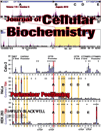
JOURNAL OF STEROID BIOCHEMISTRY AND MOLECULAR BIOLOGY
Scope & Guideline
Advancing the Frontiers of Steroid Science
Introduction
Aims and Scopes
- Steroid Biochemistry and Metabolism:
Research in this area involves the study of biochemical pathways related to steroid hormones, including their synthesis, metabolism, and the role of enzymes such as cytochrome P450 in steroidogenesis. - Hormonal Regulation and Disease:
This scope focuses on the impact of steroid hormones in various diseases, particularly cancers (e.g., breast and prostate cancer), metabolic disorders, and reproductive health issues. - Analytical Techniques in Steroid Research:
The journal emphasizes advancements in analytical techniques such as liquid chromatography-mass spectrometry (LC-MS/MS), which are crucial for quantifying steroid hormones and their metabolites in biological samples. - Endocrine Disruption and Environmental Factors:
Research addressing the effects of environmental chemicals and endocrine disruptors on steroid hormone function and metabolism is a key area of interest, particularly in relation to reproductive health. - Neurosteroids and Cognitive Functions:
Studies on the role of neuroactive steroids in the central nervous system and their implications for neuropsychiatric disorders and cognitive function are increasingly featured. - Clinical Applications and Therapeutics:
The journal explores the therapeutic potential of steroid hormones and their analogs in various clinical contexts, including hormone replacement therapies and cancer treatments.
Trending and Emerging
- Vitamin D and Its Metabolites:
Research on vitamin D, its metabolites, and their diverse roles in health, including immune function and disease prevention, has gained considerable attention, reflecting a broader interest in the implications of vitamin D deficiency. - Steroid Hormones in Cancer Therapy:
An increasing number of studies are exploring the role of steroid hormones in cancer treatment, particularly the development of novel therapeutic agents targeting steroid receptors in hormone-dependent tumors. - Neuroactive Steroids and Mental Health:
There is a growing focus on neuroactive steroids and their impact on mental health conditions, indicating an emerging interest in the links between steroid hormones and neuropsychiatric disorders. - Metabolomics and Personalized Medicine:
The application of metabolomics to understand individual variations in steroid metabolism and its implications for personalized medicine is a rapidly expanding area of research. - Endocrine Disruption and Public Health:
Research addressing the effects of endocrine disruptors on human health, particularly in relation to reproductive and metabolic disorders, has gained momentum, highlighting the intersection of environmental science and steroid biochemistry.
Declining or Waning
- Basic Steroid Biochemistry:
There has been a noticeable decrease in publications focusing solely on the fundamental aspects of steroid biochemistry without clinical or applied context, possibly due to the increasing complexity and translational nature of steroid research. - Historical Perspectives on Steroids:
Papers reflecting on historical developments in steroid research or retrospective analyses have become less frequent, as the focus shifts towards contemporary issues and innovative methodologies. - Plant Steroids and Phytochemistry:
Research on plant-derived steroids and their potential applications has waned, as more attention is directed towards synthetic and semi-synthetic steroid compounds with targeted therapeutic effects. - Animal Models in Steroid Research:
There seems to be a reduced emphasis on studies utilizing traditional animal models for steroid research, potentially due to the rise of in vitro and computational models that offer more direct insights into human physiology.
Similar Journals

BIOLOGICAL CHEMISTRY
Championing Excellence in Biochemistry and Molecular ScienceBIOLOGICAL CHEMISTRY, published by WALTER DE GRUYTER GMBH, is a premier journal based in Germany focusing on the ever-evolving fields of Biochemistry, Clinical Biochemistry, and Molecular Biology. With a robust reputation reflected in its top quartile rankings (Q1) within both Biochemistry and Clinical Biochemistry categories, and a commendable Q2 ranking in Molecular Biology for 2023, this journal stands as a vital resource for researchers, professionals, and students alike. The journal spans a rich history dating back to 1881 and embraces contemporary scientific discourse, ensuring accessibility to critical findings and advances that shape the biological sciences. Although it is not an open-access journal, its impactful contributions and relevant insights continue to serve the academic community. With its ISSN 1431-6730 and E-ISSN 1437-4315, BIOLOGICAL CHEMISTRY remains committed to fostering a deeper understanding of chemical processes in biological systems, driving innovation and research excellence into the future.

Archives of Endocrinology Metabolism
Bridging science and practice in metabolic disorders.Archives of Endocrinology Metabolism is a distinguished open-access journal dedicated to advancing the field of endocrinology and metabolism. Published by SBEM-SOC BRASIL ENDOCRINOLOGIA & METABOLOGIA, this journal has established itself as a vital platform for researchers, clinicians, and scholars since its inception in 2008. With an ISSN of 2359-3997 and E-ISSN of 2359-4292, it aims to disseminate high-quality research articles that explore the latest advancements in endocrinology, diabetes, and metabolism. As of 2023, it has achieved a commendable Q3 ranking in its field, demonstrating its relevancy and increasing visibility among peers. The journal's focus spans various sub-disciplines, including hormonal regulation, metabolic disorders, and innovative therapies, making it an essential resource for both emerging professionals and seasoned experts alike. With a rich repository of research from Brazil and beyond, Archives of Endocrinology Metabolism continuously seeks to contribute to the ongoing dialogue and collaboration within the global scientific community.

BIOFACTORS
Advancing the Frontiers of Biochemistry and Molecular MedicineBIOFACTORS, an esteemed journal published by Wiley, serves as a pivotal resource in the fields of Biochemistry, Clinical Biochemistry, and Molecular Medicine. With ISSN 0951-6433 and E-ISSN 1872-8081, the journal has established its reputation since its inception in 1988, showcasing a rich history of scientific inquiry and innovation. Recognized for its high academic standards, it currently holds a Q1 ranking in key categories, including Biochemistry and Medicine (miscellaneous), and ranks in the top 10% for Clinical Biochemistry according to Scopus metrics, reflecting its impact and influence in the scientific community. Although it does not offer Open Access, BIOFACTORS provides researchers the opportunity to publish and disseminate high-quality studies that advance our understanding of biological factors and their clinical implications. The journal actively encourages contributions that bridge the gap between laboratory findings and clinical applications, making it a vital platform for both seasoned researchers and emerging scholars in the life sciences.

BIOCHEMICAL AND BIOPHYSICAL RESEARCH COMMUNICATIONS
Where critical insights meet scientific excellence.BIOCHEMICAL AND BIOPHYSICAL RESEARCH COMMUNICATIONS, published by Academic Press Inc Elsevier Science, stands as a leading periodical in the fields of biochemistry, biophysics, cell biology, and molecular biology. With an ISSN of 0006-291X and an E-ISSN of 1090-2104, this esteemed journal has been a pivotal platform for the dissemination of groundbreaking research since its inception in 1959, continuing to publish influential findings through at least 2024. It holds a commendable Q2 ranking in Biochemistry and Q1 status in Biophysics as of 2023, reflecting its high impact and relevance in the field, supported by its strong Scopus rankings—ranking #43 in Biophysics and maintaining a presence in the top quartiles of several related categories. Although it is not an open-access journal, it provides critical insights and essential data that cater to researchers, professionals, and students keen on advancing their understanding of complex biochemical and biophysical processes. Its significant contributions to the scientific community underscore the importance of this journal as a reference point for innovative research and collaborative discourse.

IUBMB LIFE
Advancing the Frontiers of Life SciencesIUBMB LIFE is a prestigious, peer-reviewed journal published by WILEY, dedicated to advancing the fields of biochemistry, molecular biology, and cell biology. With an impressive impact factor and consistently ranked in the Q1 and Q2 categories across multiple relevant disciplines—including Biochemistry, Genetics, and Clinical Biochemistry—this journal has established itself as a leading platform for disseminating innovative research and critical reviews that propel scientific discovery. The journal spans a converged publication period from 1999 to 2024, providing comprehensive insights into the dynamic landscape of biochemical research. Researchers, professionals, and students alike are invited to explore its Open Access options, ensuring that groundbreaking studies are accessible to a global audience. As it continues to shape the future of life sciences, IUBMB LIFE remains a vital resource for those seeking to enrich their understanding and contribute to these rapidly evolving fields.

Biomolecules
Illuminating the path of discovery in molecular biology.Biomolecules is a prestigious, peer-reviewed journal published by MDPI that has been dedicated to advancing the field of biochemical research since its launch in 2011. With an impressive impact factor positioning it in Q1 for Biochemistry and Q2 for Molecular Biology as of 2023, this journal serves as a vital platform for disseminating high-quality research findings related to biological macromolecules, including proteins, nucleic acids, and carbohydrates. Operating as an Open Access journal, it ensures that vital research is accessible to all, furthering knowledge dissemination and collaboration within the scientific community. Located in Basel, Switzerland, the journal has established a significant presence in major academic databases, holding commendable Scopus rankings in both Biochemistry and Molecular Biology. Researchers, professionals, and students will find Biomolecules an invaluable resource for cutting-edge research, reviews, and insights in the rapidly evolving domains of biochemistry and molecular biology.

JOURNAL OF CELLULAR BIOCHEMISTRY
Connecting Researchers Through Cutting-Edge Biochemical StudiesJournal of Cellular Biochemistry is a premier academic journal dedicated to advancing the field of biochemistry and cellular biology. Published by Wiley, this influential journal has a significant impact factor that underscores its relevance and authority within the scientific community. With its ISSN 0730-2312 and E-ISSN 1097-4644, the journal has been on the frontier of research since its inception in 1982, and is expected to continue publishing cutting-edge studies through 2024. As evidenced by its ranking in the 2023 Scopus Quartiles, it holds a rank of Q2 in Biochemistry and Q3 in both Cell and Molecular Biology, placing it among the top tiers of scientific journals in these disciplines. The Journal of Cellular Biochemistry serves as a vital resource for researchers, professionals, and students alike, providing a platform for the dissemination of innovative ideas and findings that shape our understanding of cellular processes and biochemical pathways. Though it does not currently offer Open Access options, its robust peer-review process ensures that each publication meets the highest academic standards, thus solidifying its esteemed position in the landscape of biochemical research.

International Journal of Endocrinology and Metabolism
Pioneering Research for Metabolic MasteryThe International Journal of Endocrinology and Metabolism is a leading peer-reviewed publication dedicated to advancing knowledge and research in the fields of endocrinology, diabetes, and metabolism. Published by BRIEFLAND in the Netherlands, this journal features original research, comprehensive reviews, and insightful clinical studies that explore the multifaceted aspects of hormonal disorders and metabolic conditions. With an impact factor that places it in the Q3 quartile category for 2023, the journal serves as a critical resource for academics and practitioners aiming to stay at the forefront of this dynamic field. Spanning from 2010 to 2024, the journal offers an enriching platform for innovative ideas and practices, fostering collaboration among scholars and healthcare professionals alike. Although not open access, the content is meticulously curated to ensure high-quality scientific discourse, positioning the International Journal of Endocrinology and Metabolism as an essential reference for those dedicated to improving health outcomes related to endocrine and metabolic disorders.

Journal of the Endocrine Society
Transforming knowledge into clinical practice in endocrinology.Journal of the Endocrine Society, published by the ENDOCRINE SOC, stands as a prominent platform for disseminating significant research and findings within the field of endocrinology, diabetes, and metabolism. Established as an Open Access journal since 2017, it aims to increase the visibility and accessibility of vital scholarly contributions, allowing researchers and professionals from various backgrounds to engage with the latest insights in this rapidly evolving discipline. With an impressive Q2 ranking in Endocrinology, Diabetes and Metabolism, the journal is recognized for its impact, ranking #100 out of 244 in Scopus, highlighting its role in advancing scientific knowledge and fostering innovation. The journal, based in the United States at 2055 L ST NW, SUITE 600, WASHINGTON, DC 20036, continues to enrich the academic landscape by converging state-of-the-art research and clinical applications through its publication cycle from 2017 to 2024. Researchers, students, and healthcare professionals are encouraged to explore this essential resource to stay at the forefront of endocrinological advancements.

CRITICAL REVIEWS IN BIOCHEMISTRY AND MOLECULAR BIOLOGY
Unveiling Critical Perspectives in BiochemistryWelcome to Critical Reviews in Biochemistry and Molecular Biology, a premier academic journal published by Taylor & Francis Ltd, dedicated to advancing the fields of biochemistry and molecular biology. With an impressive impact factor and a Q1 ranking in both Biochemistry and Molecular Biology for 2023, this journal serves as a vital resource for researchers, professionals, and students eager to engage with cutting-edge reviews and analyses that synthesize the latest developments in these dynamic areas of study. Since its inception in 1972, the journal has maintained a commitment to high-quality scholarship, providing a platform for critical discussions that accelerate the discovery and understanding of biochemical processes and molecular interactions. Although not open access, its robust editorial peer-review process ensures that published articles meet the highest standards of scientific rigor, making it a trusted source for the scientific community. As we continue to converge toward 2024, we invite you to explore the extensive array of topics and findings that have shaped contemporary biochemistry and molecular biology.